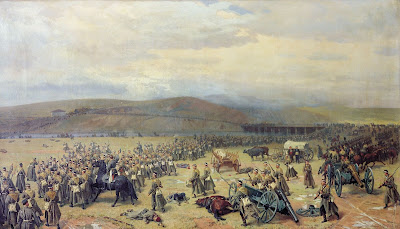In April 1876 a revolt had broke out in Bulgaria. A minor, if bloody affair, the matter would escalate over the next two years, dragging in one by one four of the Great Powers of Europe until the world was on the brink of a global war.
This was to be the last time the Great Powers would fight before the First World War. The conflict created the borders of southwestern Europe that we know today, and saw the first use of the Red crescent flag.
In the grander scheme of things, the Bulgarian revolt was part of the long decline of the Ottoman Empire. In 1683 it had been on the verge of capturing Vienna, but now had only a toe hold in Europe. But even as the Ottoman Empire declined, its great enemy, the Austrian Empire, had also waned. The balance of power in Europe was shifting. France had been humbled by defeat in the Franco-Prussian War of 1870, and so the mightiest powers in Europe were Germany, with it's great industry, Russian, with its rapidly expanding empire in Central Asia, and, of course, Britain, whose industry and empire were both the envy of the world.
It was in the interests of Russia that the Ottoman's be driven from the Balkans, so the slavs of its Christian provinces could join the Russian Empire, and it was in the interests of Britain that they stay, so that Russia could not gain a Mediterranean port from which she could threaten the flow of trade through the Suez Canal to Britain. It was in the interests of Germany that there should be peace.
In 1854 France and Britain had come to Turkey's aid when Russia had attacked. This time France was not a player and public opinion in Britain, outraged by the behaviour of Turkish irregulars was not on the side of the Ottomans.
Russian first bought off Austria-Hungary by offering them the Ottoman province of Bosnia-Herzegovia, then used her ally Serbia to attempt to capture Bulgaria. When this failed, she declared war herself.
The forces were actually fairly even. 300,000 Russians faced 200,000 Turks, who had the advantage of interior lines of communication, control of the sea, and fortified positions. In terms of abilities the two sides were very different. Russians who were strategically aggressive but tactically inept. The Ottomans were strategically passive but tactically brilliant.
This was shown by the fate of Osman Pasha, and his army of 30,000 men. Outmanoevred and surrounded, he then fought off a succession of Russian attacks in a siege that would make him famous and preserve Ottoman Europe for another forty years.
After the third failed attack on Osman's position in the unremarkable town of Plevna, when Csar Nicholas II and invited dignitaries from across Europe watched 100,000 Russian soldiers fail to defeat a force less than a third of their size, the Russians called in General Todleben, the hero of Sevastopol. He encircled the town with siege works and when the starving Turks attempted to break out they were repulsed in fierce hand-to-hand fighting. The next day Osman Pasha surrendered.
It was now December 1877. Constantinople was held by no more than 20,000 Turkish troops. By the end of January 1878 the Russian army had reached the village of San Stefano, nine miles west of Constantinople. Fearing that the great city would fall, British Prime Minister Disraeli sent the Royal Navy's Mediterranean Fleet through the Dardanelles to defend it. At the same time 200,000 Austro-Hungarian troops were massing on the border of Bosnia and Herzegovina.
The stage was now set for a confrontation between the Great Powers.






No comments:
Post a Comment